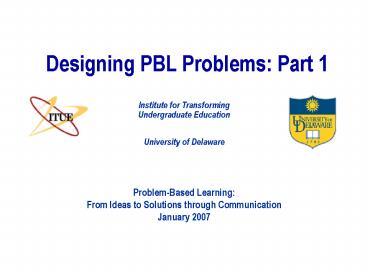Designing PBL Problems: Part 1 - PowerPoint PPT Presentation
1 / 13
Title:
Designing PBL Problems: Part 1
Description:
... (1956) Taxonomy of Educational Objectives. Bloom's Taxonomy Revised ... Fink's 'Taxonomy of Significant Learning': foundational ... Taxonomy of ... – PowerPoint PPT presentation
Number of Views:32
Avg rating:3.0/5.0
Title: Designing PBL Problems: Part 1
1
Designing PBL Problems Part 1
Institute for TransformingUndergraduate Education
University of Delaware
Problem-Based Learning From Ideas to Solutions
through Communication January 2007
2
Central Role of the Problem in PBL
Problems provide the impetus for learning by
presenting a situation in need of resolution.
- Initial analysis of problem promotes higher order
thinking, recognition of knowledge gaps
learning to learn. - Solution requires search for new knowledge and
understanding - Context provides framework for connecting new
ideas with prior knowledge - Problems relevance, interest justify student
efforts to learn. - Shared quest requires communication, promotes
teamwork.
3
A PBL Problem Capsule
4
Effective PBL Problems
- motivate student learning through real-world
relevance - pose open-ended initial questions that encourage
discussion - lead students to identify and seek out needed
information - are complex enough to promote group effort in
solving - require decision-making or judgment (development
of higher-order thinking) - address course learning objectives
5
Preparing Citizens of the Future
- Was this an effective PBL problem?
- Why or why not?
6
More on Learning Objectives
- Content Objectives
- Basic knowledge and understanding of specific
concepts, techniques, ways of knowing, etc. in a
specific discipline
- Process Objectives
- Global skills, including
- Effective communication (written and oral)
- Finding, evaluating information
- Effective teamwork
- Higher order thinking
7
Blooms Cognitive Levels
- Evaluation - make a judgment based on criteria
- Synthesis - produce something new from component
parts - Analysis - break material into parts to see
interrelationships - Application - apply concept to a new situation
- Comprehension - explain, interpret
- Knowledge - remember facts, concepts, definitions
Bloom, B.S., ed. (1956) Taxonomy of Educational
Objectives
8
Blooms Taxonomy Revised
Knowledge and cognitive domains combined
synthesis elevated above evaluation Anderson
and Krathwohl, eds. (2001) Taxonomy for Learning,
Teaching and Assessing A Revision of Blooms
Taxonomy of Educational Objectives.
9
Other Dimensions of Learning
Two prominent course design models suggest other
elements of learning that problems may address.
- Finks Taxonomy of Significant Learning
foundational knowledge, application, integration,
human dimension, caring, and learning how to
learn.
- Wiggins and McTighes Six Facets of
Understanding explanation, empathy,
interpretation, application, self-knowledge,
perspective
10
Taxonomy of Significant Learning
- Significant Learning defined as lasting,
important change in learner - not just cognitive - Interactive rather than hierarchical levels
L. Dee Fink (2003) Creating Significant Learning
Experiences An Integrated Approach to Designing
College Courses
11
Six Facets of Understanding
Wiggins and Tighe (1998), Understanding by Design
12
Rubric to Evaluate PBL Problems
Criteria include a problems realism, content,
ability to engage students, complexity,
structure/staging, resolution, questions posed,
requirements for research and resources. (Could
also evaluate associated student products,
assignments, assessments.)
13
Preparing for Part 2
- In this afternoons session, you will begin to
write a problem for your course. - Over lunch, please think about possible topics or
concepts that you might introduce through a
problem.































